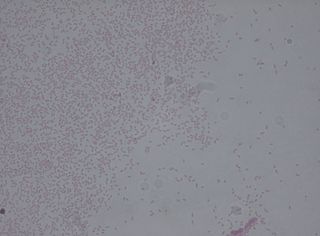Blight is a specific symptom affecting plants in response to infection by a pathogenic organism.

Fire blight, also written fireblight, is a contagious disease affecting apples, pears, and some other members of the family Rosaceae. It is a serious concern to apple and pear producers. Under optimal conditions, it can destroy an entire orchard in a single growing season.
Douglas Winton Dye was a New Zealand microbiologist.

Erwinia is a genus of Enterobacterales bacteria containing mostly plant pathogenic species which was named for the famous plant pathologist, Erwin Frink Smith. It contains Gram-negative bacteria related to Escherichia coli, Shigella, Salmonella, and Yersinia. They are primarily rod-shaped bacteria.

Thomas Jonathan Burrill was an American botanist, plant pathologist, and college administrator who first discovered bacterial causes for plant disease. He introduced Erwinia amylovora as the causal agent of pear fire blight.
Pseudomonas viridiflava is a fluorescent, Gram-negative, soil bacterium that is pathogenic to plants. It was originally isolated from the dwarf or runner bean, in Switzerland. Based on 16S rRNA analysis, P. viridiflava has been placed in the P. syringae group. Following ribotypical analysis misidentified strains of Pseudomonas syringae pv. ribicola and Pseudomonas syringae pv. primulae were incorporated into this species. This pathogen causes bacterial blight of Kiwifruit.

Xanthomonas is a genus of bacteria, many of which cause plant diseases. There are at least 27 plant associated Xanthomonas spp., that all together infect at least 400 plant species. Different species typically have specific host and/or tissue range and colonization strategies.

Pantoea agglomerans is a Gram-negative bacterium that belongs to the family Erwiniaceae.
Xanthomonas arboricola is a species of bacteria. This phytopathogenic bacterium can cause disease in trees like Prunus, hazelnut and walnut.

Cotoneaster salicifolius, the willow-leaved cotoneaster, is a drought-tolerant, evergreen to semi-evergreen, low-lying, small to medium-sized shrub with an arched branching habit. Specimens growing in the wild, however, are generally larger, averaging five meters in height. Although native to the mountains, mixed forests, and open places in western China, it is commonly cultivated in temperate climates worldwide. Cultivars have been bred in a variety of forms, as ornamental groundcovers or shrubs.
Copper pesticides are copper compounds used as bactericides, algaecides, or fungicides. They can kill bacteria, oomycetes and algae, and prevent fungal spores from germinating. Common forms of fixed copper fungicides include copper sulfate, copper sulfate pentahydrate, copper hydroxide, copper oxychloride sulfate, cuprous oxide, and copper octanoate.
The Harovin Sundown pear is a late-season fresh market pear with good storage capability. It is highly productive with no biennial bearing. The tree has excellent resistance to fire blight. This new cultivar, developed by Agriculture and Agri-Food Canada (AAFC) at its Research Centers in Harrow and Vineland Station, Ontario, Canada, is recommended by the Ontario Tender Fruit Producers' Marketing Board for general planting in Ontario. It is protected under Canadian Plant Breeders Rights legislation.
Xanthomonas axonopodis pv. manihotis is the pathogen that causes bacterial blight of cassava. Originally discovered in Brazil in 1912, the disease has followed the cultivation of cassava across the world. Among diseases which afflict cassava worldwide, bacterial blight causes the largest losses in terms of yield.
Bacterial wilt of turfgrass is the only known bacterial disease of turf. The causal agent is the Gram negative bacterium Xanthomonas translucens pv. graminis. The first case of bacterial wilt of turf was reported in a cultivar of creeping bentgrass known as Toronto or C-15, which is found throughout the midwestern United States. Until the causal agent was identified in 1984, the disease was referred to simply as C-15 decline. This disease is almost exclusively found on putting greens at golf courses where extensive mowing creates wounds in the grass which the pathogen uses in order to enter the host and cause disease.

Xanthomonas oryzae pv. oryzae is a bacterial pathovar that causes a serious blight of rice, other grasses, and sedges.
Robert S. Dickey was an American phytopathologist, professor emeritus of Plant Pathology at the Cornell University and the namesake of the bacterial genus Dickeya.
Allan Ross Ferguson is a New Zealand botanist who has made significant contributions in the field of kiwifruit scientific investigation. The standard author abbreviation A.R.Ferguson is used to indicate this person as the author when citing a botanical name.
Xanthomonas campestris pv. juglandis is an anaerobic, Gram negative, rod-shaped bacteria that can affect walnut trees though the flowers, buds, shoots, branches, trunk, and fruit. It can have devastating effects including premature fruit drop and lesions on the plant. This pathogen was first isolated by Newton B. Pierce in California in 1896 and was then named Pseudomonas juglandis. In 1905 it was reclassified as Bacterium juglandis, in 1930 it became Phytomas juglandis, and in 1939 it was named Xanthomas juglandis. The International Standards for Naming Pathovars declared it to be named Xanthomonas campestris pv. juglandis in 1980. There have been recent proposals to change the name once again to Xanthomonas arboricola pv. juglandis, but this has not yet been universally accepted.
Eve Billing (1923–2019) was a UK plant pathologist specialising in diseases of fruit trees especially fire blight caused by Erwinia amylovora bacteria. She introduced a modelling system to predict the likelihood of outbreaks of fire blight and also methods for pathogen identification and treatment.
Xanthomonas pruni is a bacterial disease of almost all Prunus.






